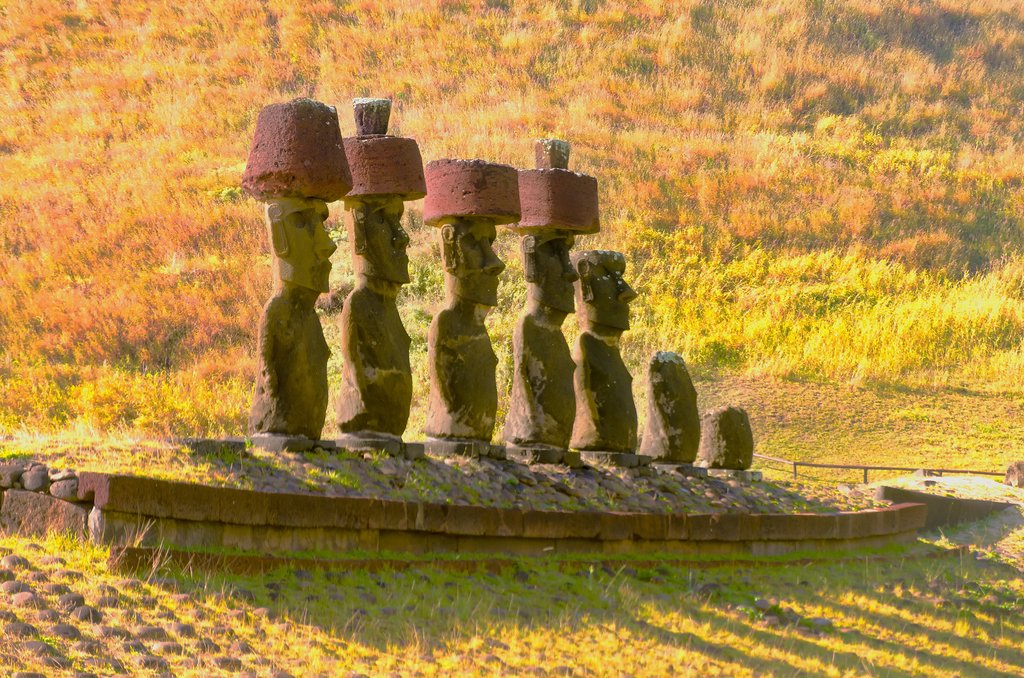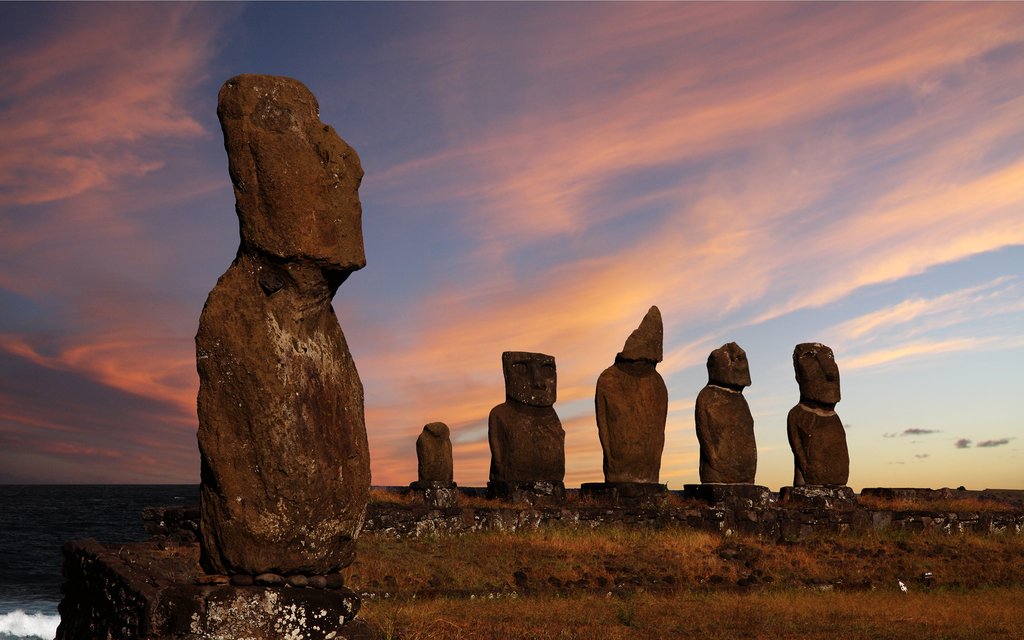Incredible Easter Island
Located thousands of miles west of mainland Chile, Easter Island (Isla de Pascua in Spanish) is known by its indigenous residents as Rapa Nui. The tiny island is home to around 7,000 people, with the vast majority living in Hanga Roa, the island's only town. Roughly half of the population are indigenous Rapa Nui and speak a Polynesian-based language—the rest are from mainland Chile, with a sprinkling of foreigners. The most famous inhabitants, however, are its 400 or so moai, inscrutable monolithic statues quite unlike anything else on earth.
Easter Island was first settled around 1000 BCE by Polynesian migrants, whose expert carvers started to produce the island’s signature statues. These statues represented important ancestors and were thought to watch over the islanders and provide protection. The society grew increasingly complex until overpopulation, deforestation, food shortages, and conflict pushed it into decline. On Easter Sunday, 1722, the island was “discovered” by a Dutch sailor—and within a century, slave traders had decimated the population.
Christian missionaries followed in the 1860s and Chile eventually annexed the island in 1888. It took almost 80 years for the Rapa Nui people to gain full Chilean citizenship and the right to vote, but today they have a degree of autonomy over the island they often refer to as Te Pito o Te Henua (Navel of the world). With the recent protection of Easter Island's marine reserve (one of the largest in the world), a bevy of annual events open to the public, and great restaurants and lodging options around Hanga Roa, there's never been a better time to visit this legendary island.
Planning Your Visit

Given the distance, the high cost of flights and the fact that you’re unlikely to make repeat visits, it’s worth spending at least three days on Easter Island to take in all the key sites. A five-day stay allows you to explore at a more leisurely pace and fit in a diving, snorkeling or horseriding excursion. Easter Island is also a great addition to other popular destinations in Chile—combine it with the Atacama Desert for a two-week trip like this one, or add three days of exploration in Torres del Paine.
Chilean tourist visas are available on arrival at airports and land borders for most nationalities and generally last 90 days. Some nationalities—including, at the time of writing, Canadians and Australians—have to pay a “reciprocity fee”, an arrival tax equivalent to the amount Chilean travelers are charged for visiting the country in question. There is no malaria or yellow fever on Easter Island (or, indeed, mainland Chile) and no special vaccinations are required to visit.
There are a couple of banks with ATMs in Hanga Roa, several places change foreign currency (at poor rates) and credit/debit cards are accepted by some of the bigger establishments. Nevertheless, it is wise to bring some cash: as well as Chilean pesos, many places accept US dollars. Easter Island is significantly more expensive than mainland Chile, so be prepared.
Weather
Easter Island has a warm, sub-tropical climate and can be visited year-round. Temperatures generally range between 61°F (16°C) and 77°F (25°C), with December to April the warmest period. It can rain at any time of the year, with April-June the wettest months, though rarely enough to spoil your visit. Bring a rain jacket and an umbrella, to be on the safe side.
Getting There & Away
Easter Island’s tiny airport, Mataveri, is just outside Hanga Roa. The only airline serving the island is LATAM, which has daily flights to/from the Chilean capital Santiago (4hr 50min–5hr 40min) and weekly ones to/from Papeete in Tahiti (5hr 50min). Most hotels offer a free airport pick-up/drop-off service, though you can walk to/from Hanga Roa if you’re traveling light. The only other way to visit the island is on a cruise.
Transport Options
Most travelers explore the island on a guided tour, though some of these are quite rushed. Hiring a car, motorbike or quad bike gives you more freedom and can easily be arranged in Hanga Roa: note that there is no car insurance on Easter Island and semi-feral horses can be a hazard for drivers. Closer sites can be visited on foot or bike (which are also widely available to hire), and horseback tours can be particularly memorable. Taxis are in short supply.
Chat with a local specialist who can help organize your trip.
Highlights & Activities

Easter Island’s many moai sites are, of course, the major attractions, but there are also some beautiful beaches, volcanic craters, cliff-top archeological sites and diving spots to explore too. Most places of interest are covered by Rapa Nui National Park: entry tickets can be bought at the airport when you arrive.
Ahu Tongariki
The most famous site on the island, located on the east coast, Ahu Tongariki is a magnificent collection of 15 huge moai—some weighing up to 30 tons—lined up on a 650-foot ahu (stone pedestal). Knocked over by a tsunami in 1960, the statues were eventually put back to their rightful positions in 1995. This is the best place on the island to watch the sun rise.
Rano Raraku
Just inland from Ahu Tongariki, the volcanic crater of Rano Raraku is where most of the moai were made. They were carved directly from the tuff (compacted volcanic ash) and transported to sites around the island, probably on wooden sleds. Many, however, were left unfinished or proved too heavy to move and today their heads poke out of Rano Raraku’s grassy slopes at odd angles. Keep an eye out for El Gigante (The Giant): at over 65 feet, he is the tallest ever carved. Sadly, he was never completed and remains attached to the rock face.
Rano Kau and Orongo
On the south coast of the island is the dramatic flooded crater of the extinct Rano Kau volcano. On one side a chunk has been blown out by a historic eruption, offering up views of the ocean beyond. Nearby are the clifftop ruins of Orongo village. Here you’ll find a collection of impressive petroglyphs celebrating the Birdman Ceremony, an annual competition amongst chiefs of the various kin-groups. The chief whose representative returned from a nearby islet with the first sooty tern egg of the season won the right to dominate the rest of the groups for the year ahead.
Anakena beach
According to local legend, the very first settlers landed on Anakena beach, on the north coast of the island. Today this palm-fringed stretch of golden sand is a great spot for a swim or a sunbathe, though there are also some intriguing moai to see too.
Tahai
A short walk north of Hanga Roa takes you to Tahai, a ceremonial spot with a selection of ahus and moai. In the late afternoon crowds of locals and tourists gather here to watch the sunset. Nearby is the Father Sebastian Englert Archeological Museum, which provides an excellent overview of the island’s history and culture.
Scuba diving and snorkeling
One of the world’s largest marine reserves was created around Easter Island in 2017 and its warm, crystal clear waters are ideal for scuba diving and snorkeling trips. If you’re lucky, you may even get the chance to swim alongside a green sea turtle.
Festivals & Special Events

The best time to visit Easter Island is during one of its handful of festivals. During these periods—particularly Tapati Rapa Nui—demand for flights, accommodation and car hire rises, sometimes significantly, so book well in advance. Here are the island’s key fiestas.
Tapati Rapa Nui (Early February): This two-week event is the biggest fiesta of the year, celebrating Rapa Nui culture and history through the election of the “Queen of the Tapati”, music and dance performances, canoe and horse races, statue carving, feasting, and much more.
Semana Santa (March/April): Holy Week (aka Easter) celebrations on the island are centered around Hanga Roa’s pretty little church.
Dia de la Lengua Rapa Nui (Early November): The Day of the Rapa Nui Language celebrates the local tongue with a variety of cultural events.
Where to Stay
Easter Island has a good range of campsites, hostels, guesthouses, and mid- and top-end hotels, though all are significantly more expensive than their counterparts on the mainland. Almost all are in or around Hanga Roa; the main exception is the luxurious Explora Rapa Nui, which is 8km east of town.
Camping Mihinoa is the best bet for backpackers and budget travelers, while Hostal Tojika is a solid mid-range choice. Alongside Explora Rapa Nui, the top high-end option is Hotel Hangaroa Eco Village & Spa. Wherever you stay, book well in advance, particularly if your visit coincides with Tapati Rapa Nui or Semana Santa.
Where to Eat
Hanga Roa has a good selection of cafes, restaurants, and bars, though again prices are on the high side. Unsurprisingly, the fish and seafood are excellent, particularly the tuna and rape rape (a small lobster). One traditional dish to keep an eye out for is curanto: a hearty combo of meat, fish, and vegetables slow-cooked over hot volcanic rocks in a pit dug in the ground. Tourists can sample the dish at one of the regular dinner-and-dance shows, such as Kari Kari.
On the north edge of Hanga Roa and run by a Belgian-Rapa Nui couple, Au Bout du Monde has one of the most creative menus on the island and is rightly famous for its delicious chocolate mousse. Overlooking the sea, Haka Honu serves up excellent fish dishes—try the zingy ceviche.
If you’re on a budget, head to Tia Berta on the main street for inexpensive but tasty seafood empanadas. Meanwhile, on the dock, Mikafe is a great little spot for ice cream and coffee. Ideally located for watching the sunset, Te Moana offers well-mixed cocktails and ice-cold Mahina beer, produced by the island’s own microbrewery.
